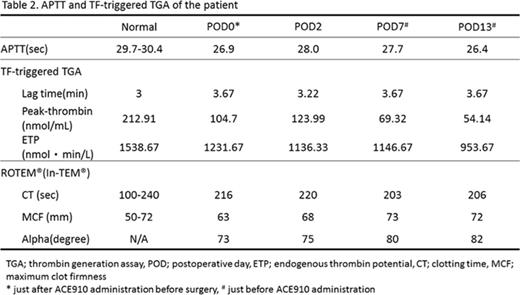Abstract
Background
FVIIIa acts as a cofactor in the intrinsic pathway in which FIXa activates FX. ACE910 is a FIXa/FX-recognizing bispecific antibody that was designed to be a replacement for FVIIIa. Because of its nature, ACE910 is not affected by FVIII inhibitor. A clinical trial is now being conducted for the potential effect in the prophylactic treatment for bleeding hemophilia A patients. Here we present the perioperative care of a patient who had incidentally suffered from appendicitis and underwent an emergency surgery during the clinical trial.
Methods
Plasma ACE910 concentration and FXIa-triggered thrombin generation assay (TGA) was obtained in the central measurement of the trial. An activated partial thromboplastin time (APTT), and the tissue factor (TF)-triggered TGA were conducted at our laboratory. TF-triggered TGA was performed by means of calibrated automated thrombogram (Thrombinoscope BV), in accordance with the manufacturer's instructions. We used PPP-reagent LOWTM and FluCa-KitTM in Fluoroscan Ascent FLTM (Thermo Fisher Scientific Inc.) and monitored the thrombin generation for 2 hours, set at an excitation wavelength of 390 nm and an emission wavelength of 460 nm, and ThrombinoscopeTM software (Thrombinoscope BV). ROTEM® was performed as manufactured (Tem Innovations GmbH).
Case
The patient is a 60-year-old man suffering from hemophilia A without inhibitors and had severe hemophilic arthropathy in the number of target joints. Even after biweekly prophylaxis had been introduced by 2000 units of rFVIII concentrates, the annualized bleeding rate remained to be 10.1 In November 2013, ACE910 was introduced by way of subcutaneous administration and the initial dose was 3 mg/kg, followed by weekly administration of 1 mg/kg. After that, he had not had any of joint or soft tissue bleeding. In the 63rd week after the initial administration, he had severe abdominal pain and diagnosed as acute appendicitis that required emergency surgery. His APTT was consistently normal since ACE910 administration, we selected to undergo the surgery without any additional FVIII replacement, although his previous product was set up to be administrated any time on demand. ACE910 had been administered as scheduled earlier on the day of the diagnosis of acute appendicitis, followed by the emergency appendectomy.
Results
The appendectomy was performed by pararectal incision. Although the patient's appendix was necrosed and perforated, it was easy to stop bleeding during surgery and the total amount of bleeding was only 45 mL. On postoperative day 11, a small amount of bleeding was found after the removal of drainage catheter placed subfascially, however, the bleeding stopped immediately after the bleeding site was sutured. No other issues on bleeding were found.
Trough levels of plasma ACE910 concentration were maintained at 27-41 µg/mL during the period between the 12th week after the initiation of ACE910 and the time of preoperative stage. In FXIa-triggered TGA, lag time was remarkably improved after the initiation of ACE910 and remained stable throughout the course of emergency surgery (Table 1). Although peak thrombin levels were slightly decreased a week after surgery, APTT and several In-TEM values by ROTEM® remained at almost normal levels (Table 2).
Discussion and Conclusion
We successfully conducted the hemostatic management for appendicitis in the perioperative period without any additional administration of FVIII concentrate. The patient showed less bleeding under ACE910 prophylaxis. To date there are little information on appropriate use of FVIII concentrate in patients with acute bleeding or major surgery who are under ACE910 prophylaxis. Generally in bleeding hemophilic patients with major surgery, the loss of clotting factors due to hemodilution by fluid replacement should also be carefully monitored. In such condition, the optimum ACE910 concentration could not be well interpreted, however, the careful monitoring might be required especially in highly invasive surgeries. In our experience, TF-triggered TGA demonstrated a marginal change only between postoperative days 7 and 13, although it is not totally known whether these changes were affected by ACE910 pharmacodynamics. Further researches are needed to explore the suitable biomarkers to indicate hemostasis of hemophilic patients under the administration of ACE910.
Suzuki:Baxalta: Honoraria; Bayer Healthcare: Honoraria; Novo Nordisk Pharma: Honoraria. Kiyoi:Novartis Pharma K.K.: Research Funding; MSD K.K.: Research Funding; Pfizer Inc.: Research Funding; Takeda Pharmaceutical Co., Ltd.: Research Funding; Yakult Honsha Co.,Ltd.: Research Funding; Alexion Pharmaceuticals: Research Funding; Teijin Ltd.: Research Funding; Taisho Toyama Pharmaceutical Co., Ltd.: Research Funding; Eisai Co., Ltd.: Research Funding; Astellas Pharma Inc.: Consultancy, Research Funding; Japan Blood Products Organization: Research Funding; Nippon Shinyaku Co., Ltd.: Research Funding; FUJIFILM RI Pharma Co.,Ltd.: Research Funding; Nippon Boehringer Ingelheim Co., Ltd.: Research Funding; FUJIFILM Corporation: Patents & Royalties, Research Funding; Zenyaku Kogyo Co., Ltd.: Research Funding; Sumitomo Dainippon Pharma Co., Ltd.: Research Funding; Kyowa Hakko Kirin Co., Ltd.: Consultancy, Research Funding; Bristol-Myers Squibb: Research Funding; Chugai Pharmaceutical Co., Ltd.: Research Funding; Mochida Pharmaceutical Co., Ltd.: Research Funding. Kasai:Chugai Pharmaceutical Co., Ltd.: Employment. Matsushita:Asahi Kasei Pharma: Honoraria, Research Funding, Speakers Bureau; Sysmex: Speakers Bureau; Octapharma AG: Honoraria; Kyowa-Kirin: Honoraria, Research Funding; CLS-Behling: Research Funding; Biogen: Honoraria, Membership on an entity's Board of Directors or advisory committees, Research Funding, Speakers Bureau; Bayer Healthcare: Honoraria, Membership on an entity's Board of Directors or advisory committees, Research Funding, Speakers Bureau; Seamens: Speakers Bureau; Nihon Pharmaceutical: Honoraria, Research Funding, Speakers Bureau; Kaketsuken: Honoraria, Research Funding, Speakers Bureau; Eisai: Research Funding; Baxalta: Honoraria, Membership on an entity's Board of Directors or advisory committees, Research Funding, Speakers Bureau; Japan Blood Products Organization: Honoraria, Research Funding; Novartis Pharma: Honoraria, Speakers Bureau; Pfizer: Honoraria, Membership on an entity's Board of Directors or advisory committees, Research Funding, Speakers Bureau; Novo Nordisk Pharma: Honoraria, Membership on an entity's Board of Directors or advisory committees, Research Funding, Speakers Bureau; Chugai Pharmaceutical Co., Ltd.: Research Funding.
Author notes
Asterisk with author names denotes non-ASH members.



This feature is available to Subscribers Only
Sign In or Create an Account Close Modal